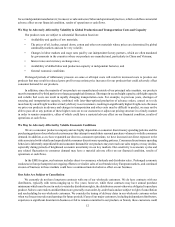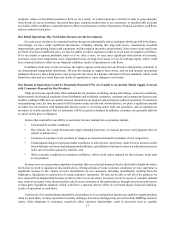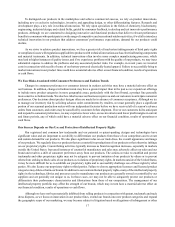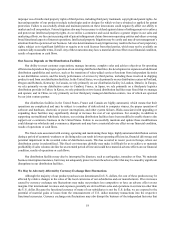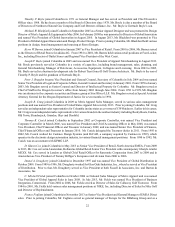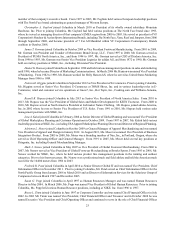Columbia Sportswear 2013 Annual Report Download - page 22
Download and view the complete annual report
Please find page 22 of the 2013 Columbia Sportswear annual report below. You can navigate through the pages in the report by either clicking on the pages listed below, or by using the keyword search tool below to find specific information within the annual report.18
improper use of intellectual property rights of third parties, including third party trademark, copyright and patent rights. An
increasing number of our products include technologies and/or designs for which we have obtained or applied for patent
protection. Failure to successfully obtain and maintain patents on these innovations could negatively affect our ability to
market and sell our products. Future litigation also may be necessary to defend against claims of infringement or to enforce
and protect our intellectual property rights. As we utilize e-commerce and social media to a greater degree in our sales and
marketing efforts, we face an increasing risk of patent infringement claims from non-operating entities and others covering
broad functional aspects of internet operations. Intellectual property litigation may be costly and may divert management’s
attention from the operation of our business. Adverse determinations in any litigation may result in the loss of our proprietary
rights, subject us to significant liabilities or require us to seek licenses from third parties, which may not be available on
commercially reasonable terms, if at all. Any of these outcomes may have a material adverse effect on our financial condition,
results of operations or cash flows.
Our Success Depends on Our Distribution Facilities
Our ability to meet customer expectations, manage inventory, complete sales and achieve objectives for operating
efficiencies depends on the proper operation of our existing distribution facilities, the development or expansion of additional
distribution capabilities and services, such as the transition of value-added services functions from independent factories
to our distribution centers, and the timely performance of services by third parties, including those involved in shipping
product to and from our distribution facilities. In the United States, we rely primarily on our distribution centers in Portland,
Oregon and Robards, Kentucky; in Canada, we rely primarily on our distribution facility in London, Ontario; in Europe,
we rely primarily on our distribution center in Cambrai, France; in Japan, we rely primarily on a third-party logistics
distribution provider in Tokyo; in Korea, we rely primarily on two leased distribution facilities near Seoul that we manage
and operate; and in China, we rely primarily on four third-party managed distribution centers, two of which are operated
by our joint venture partner.
Our distribution facilities in the United States, France and Canada are highly automated, which means that their
operations are complicated and may be subject to a number of risks related to computer viruses, the proper operation of
software and hardware, electronic or power interruptions, and other system failures. Risks associated with upgrading or
expanding these facilities may significantly disrupt or increase the cost of our operations. For example, in addition to
supporting our traditional wholesale business, our existing distribution facilities have been modified to enable them to also
support our e-commerce business in the United States. Failure to successfully maintain and update these modifications
could disrupt our wholesale and e-commerce shipments and may have a material adverse effect on our financial condition,
results of operations or cash flows.
The fixed costs associated with owning, operating and maintaining these large, highly automated distribution centers
during a period of economic weakness or declining sales can result in lower operating efficiencies, financial deleverage and
potential impairment in the recorded value of distribution assets. This has occurred in recent years in Europe, where our
distribution center is underutilized. This fixed cost structure globally may make it difficult for us to achieve or maintain
profitability if sales volumes decline for an extended period of time and could have material adverse effects on our financial
condition, results of operations or cash flows.
Our distribution facilities may also be interrupted by disasters, such as earthquakes, tornadoes or fires. We maintain
business interruption insurance, but it may not adequately protect us from the adverse effect that may be caused by significant
disruptions in our distribution facilities.
We May be Adversely Affected by Currency Exchange Rate Fluctuations
Although the majority of our product purchases are denominated in U.S. dollars, the cost of these products may be
affected by relative changes in the value of the local currencies of our subsidiaries and our manufacturers. Price increases
caused by currency exchange rate fluctuations may make our products less competitive or have an adverse effect on our
margins. Our international revenues and expenses generally are derived from sales and operations in currencies other than
the U.S. dollar. Because the functional currency of many of our subsidiaries is not the U.S. dollar, we are exposed to the
potential of material gains or losses from the remeasurement of U.S. dollar monetary transactions into the respective
functional currencies. Currency exchange rate fluctuations may also disrupt the business of the independent factories that






